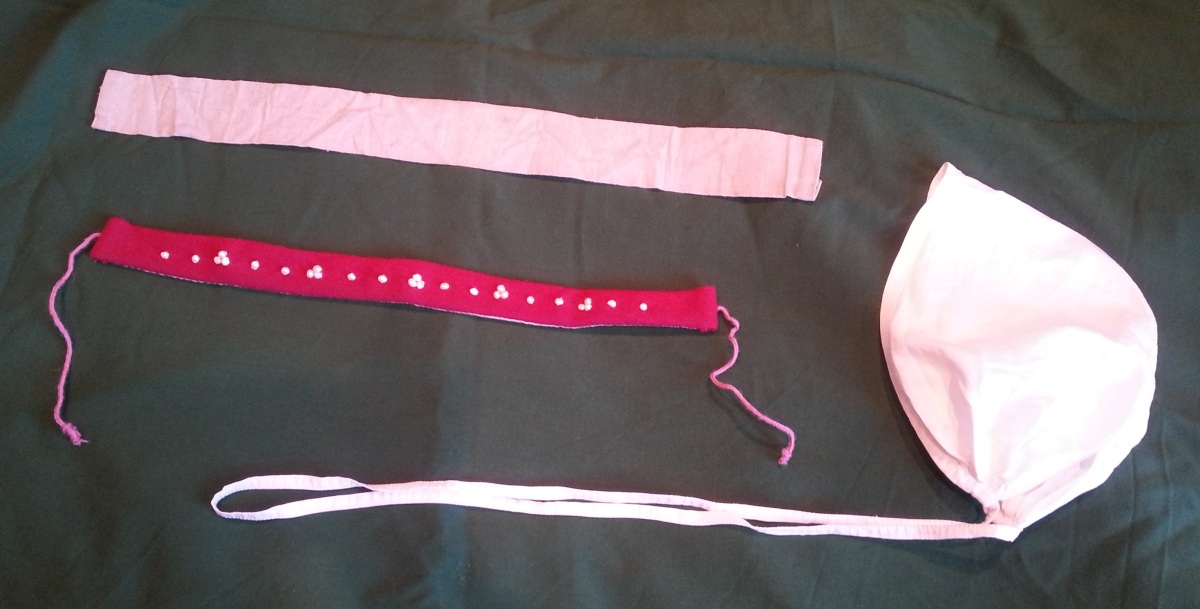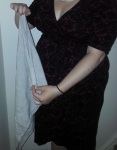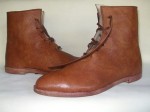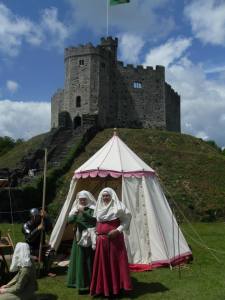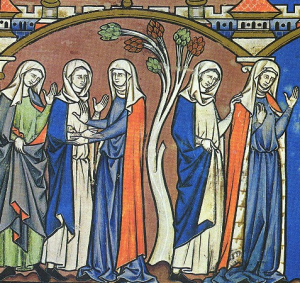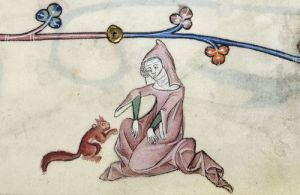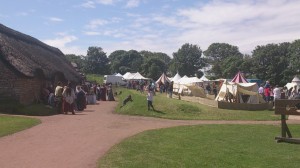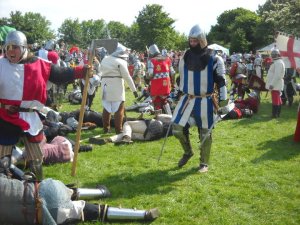Garrison ladies use several types of head covering, including veils, wimples and caps. This blog post will focus on how to put on and wear these styles using step by step photographs.
For information relating to the history and evidence for ladies’ headcoverings, please see this blog post.
You will need:
Fillet: A fillet is a strip of cloth which is pinned around your head and under your hair, holding it back and offering something to secure your veils to. This also makes your hair less likely to fall forward when your veil is on. A fillet needs to be long enough to wrap around your head once, as shown below, plus leave around a 2 inch overlap. A basic fillet should be at least 2 inches wide and long enough to go around your head and pin at the back. Decorative fillets often show more variation due to their decorative elements; this version ties at the back. The basic fillet shown here measures 2.5 x 25 inches.
St Birgitta’s Cap: This is a ladies’ cap, somewhat similar to a man’s coif, designed to encapsulate all of your hair whilst providing a secure foundation to pin the rest of your veils to. The St Birgitta’s cap can be a very useful item of underpinning, especially if you need to cover modern hair colours, piercings, or tattoos. There is a very detailed description of how to make them in Medieval Clothing and Textiles 4 by Netherton and Owen-Crocker, and fellow medieval re-enactor Katafalk provides an easy-to-follow tutorial here.
Veil Pins: These can be made of various different materials including brass, steel, silver, or gold. They should be a minimum of 1.5 inches long and a maximum of 2.5 inches long to secure veils effectively. 3-4 of these are necessary for most headcovering styles.
Veil: Your veil should be wide enough to cover your hair from the top of your forehead to approximately to the top of your bra band, though this can vary depending on the amount of hair you have and your height; the important thing is to ensure that all of your hair is covered. The basic veil shown here measures 24 x 29.5 inches.
Wimple: Your wimple should be long enough to go from the crown of your head, under your chin, and return to the crown of your head and cross over with approximately a 2 inch overlap. The basic wimple shown here measures 13 x 32 inches.
Underpinnings
Veil styles, from the simplistic to the complex, often benefit from having something underneath to secure them to. Here, we show two options commonly worn by Garrison ladies: the fillet and the St Birgitta’s Cap.
Fillet: The short strip shown in the underpinnings photograph.
To put on a fillet, wrap it around your head in front of your hair and cross the ends over at the back, leaving around a 2 inch overlap, and pin together.
St Birgitta’s Cap: The small cap shown in the underpinnings photograph. To put on a St Birgitta’s Cap, follow the directions below.
If you have long hair, you need to ensure that it is contained under more conservative veil styles. Loose hair under veils is not shown in period manuscripts and hair is almost exclusively shown as dressed even when uncovered. We in the Garrison strongly recommend placing it in some sort of bun or plait, or having a go at a medieval style.
Simple Veils
A simple veil is a younger woman’s style and is less conservative because it doesn’t cover the neck as a wimple does. When re-enacting, the style is advantageous because it is cooler, shows off your neck, and has the potential for authentic hairstyles including cornettes and ramshorns. It is less helpful in covering up inauthentic tattoos and piercings, however, and does not offer as much protection from the sun. This is how to put on a simple veil securely.
Wimple and Veil Combination
A wimple is a cloth which covers your neck and is usually worn in conjunction with a veil to cover your hair. It is a more conservative style because it covers up more, and is advantageous to re-enactors because it is very effective at covering up inauthentic hair colour, tattoos, or piercings, and offers a great deal of protection from the sun. It is also possible to use the combination in conjunction to authentic hairstyles such as ramshorns and cornettes. This is a guide to how to put on a wimple and veil securely.
Wrapped Veil Style
A wrapped veil style is a thoroughly versatile style because it is only made from one, long piece of cloth, and it is possible to vary how conservative you make it based on how far back you place it on your head. This style is advantageous because it provides a great deal of coverage using minimal cloth
Married Women’s and Widow’s Veil
A widow’s veil is a highly conservative style of veil which covers the jawline as well as the hair and neck.
High-class veils
Higher-class ladies could be less conservative in their veiling. They could also often afford more expensive and complex versions of the above styles.
Wrapped veil: This style is very similar to the wrapped style above, but there are some variations in pinning and the veil is made from a linen/silk mix cloth of a very loose weave. This allows some hair to be seen underneath it while still technically covering the hair. It is also set further back on the head, showing some hair at the front.
Frilled veil: This style is a variation on the simple veil style, though it is here worn with a wimple in addition to this. A longer frill may also be worn with a wrapped veil. Note: this style is also known as the goffered or nebule veil.
High-class simple veil: This veil is another variation on the simple veil, but is made from silk/linen mix fabric and is pinned much further back on the head, showing far more hair.
High class silk veil with decorative fillet:
This is the highest class headcovering style shown here because of the pearl decoration on the fillet and the silk of the veil.
Hoods and Hats
A variety of hoods and hats may be worn in addition to veils, but are always worn in conjunction with them as per these images:
Common Veiling Errors
There are certain common veiling errors which may be observed among re-enactors:
Thank you for reading, and we hope you found everything useful! This post is brought to you by Munchkin, who, as you can see, clearly helped.

